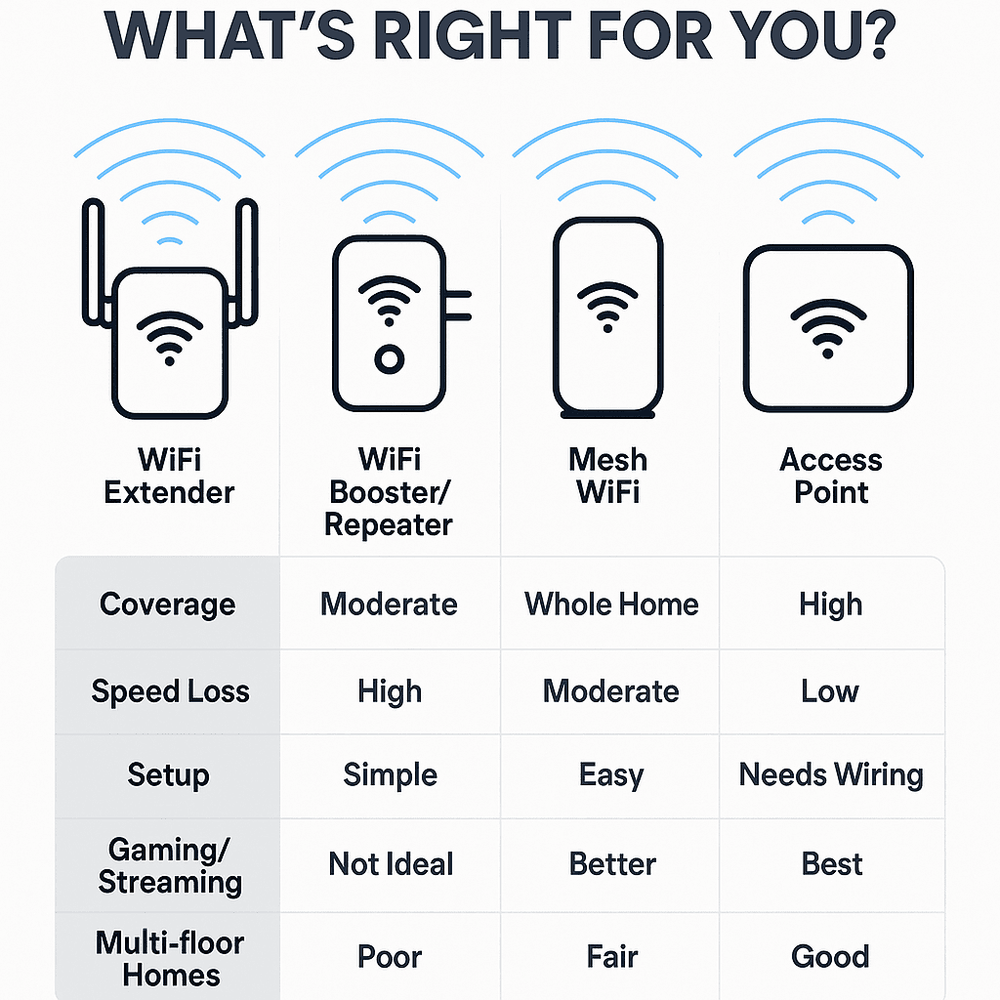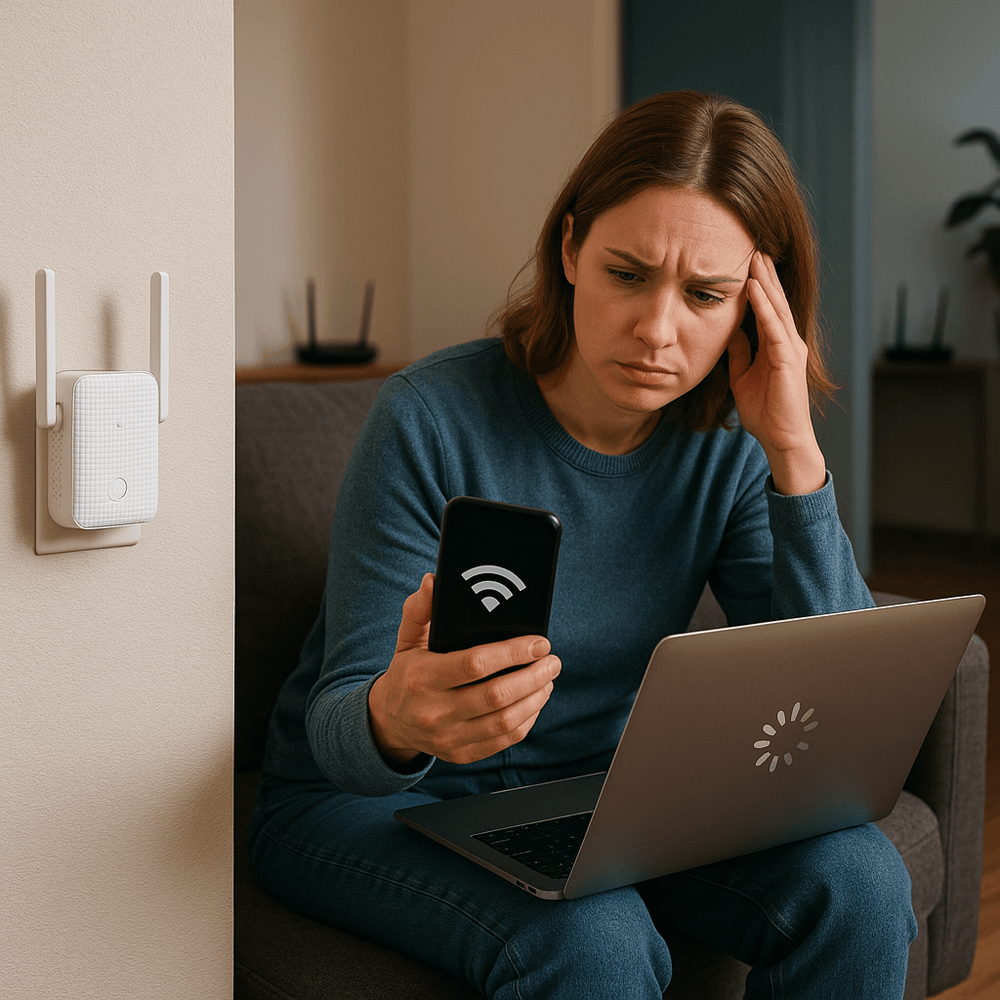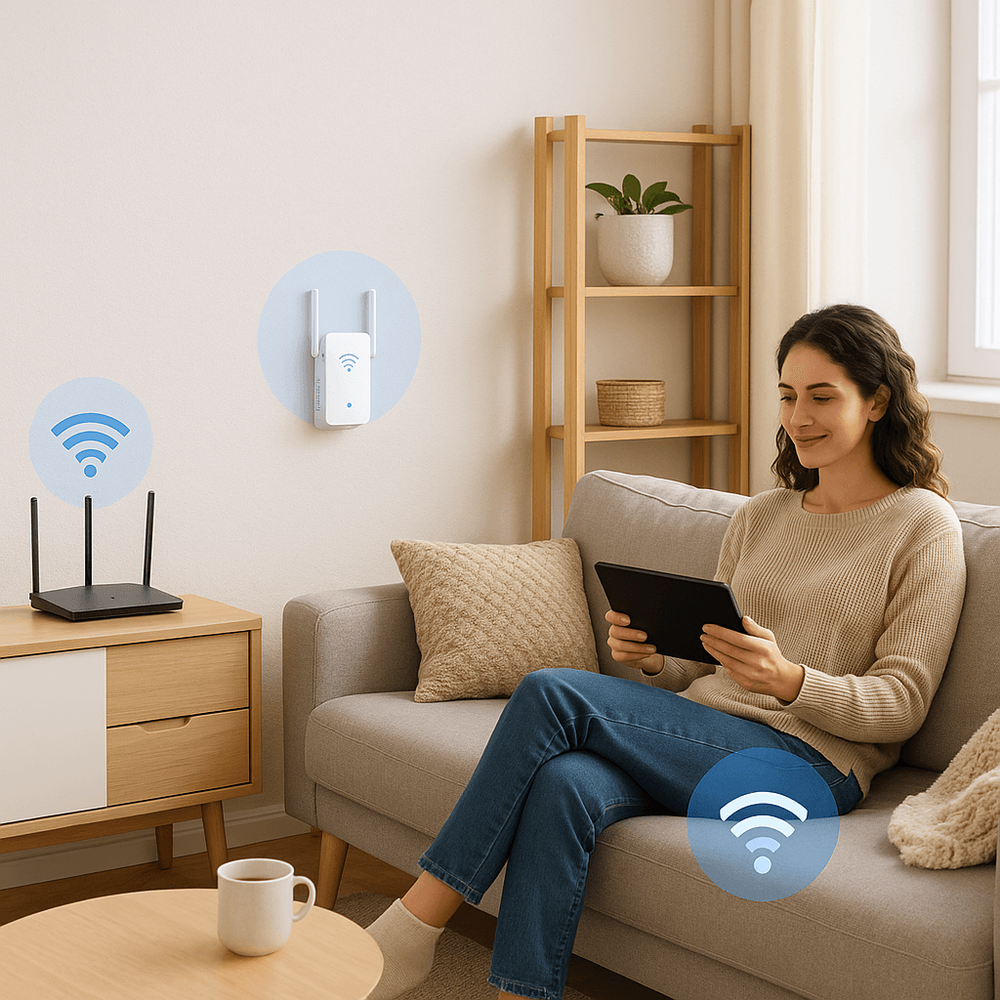Real-World Results: Do WiFi Extender Signal Boosters Actually Solve Dead Zones? Expert Tests + Honest Comparisons
Real-World Results: Do WiFi Extender Signal Boosters Actually Solve Dead Zones? Expert Tests + Honest Comparisons
Introduction: The Truth About WiFi Extender Signal Boosters
Searching for a way to eliminate WiFi dead zones in your home? Whether you're frustrated by dropped video calls, spotty streaming in the basement, or weak WiFi in your garage, you're not alone. Many homeowners look to a WiFi extender signal booster or WiFi range extender hoping for an easy fix to increase WiFi coverage and improve WiFi signal throughout their space.

But while a WiFi signal booster promises to quickly solve connectivity issues, the reality is more complex. Do these devices really improve weak spots, or are there tradeoffs you should know before buying? Myths abound—some think plugging in any extender guarantees full speed everywhere. In this honest, hands-on guide, you’ll get expert, real-world insights, clear comparisons, and practical advice based on actual test results. Find out if a WiFi extender signal booster is right for your needs, and learn what to expect before you invest.
How Does a WiFi Extender Work? Understanding the Technology
WiFi fixes can seem confusing with all the jargon: WiFi range extender, repeater, booster, amplifier. Here's how they differ:
- A WiFi range extender connects wirelessly to your router and then repeats, or “extends,” that signal into areas with spotty coverage.
- A WiFi repeater basically does the same thing as an extender—amplifying the network's reach by repeating signals.
- WiFi booster is a broad term, sometimes used for extenders, repeaters, or even high-gain antennas.
- WiFi amplifier just makes the signal stronger, but doesn’t actually extend it further.
How does a WiFi extender work? It takes your router’s signal and rebroadcasts it to boost WiFi in a room or zone where coverage is weak. Most are plug-in devices and can be set up in minutes.
The catch?
- Speed Drops: In most home setups, every hop through an extender usually cuts your speed in half.
- Best Use: Extenders are ideal for patching a single dead zone or small area, not for blanketing a big or complex home with reliable speed.
- Walls Matter: Even the best extenders or boosters struggle with very thick walls, concrete, or long distances.

In summary:
- Repeaters: Cheaper, can drop speeds significantly.
- Extenders: Some support wired backhaul (Ethernet), meaning you can connect them to the router using a cable for better speeds.
- Mesh Systems: Work as a team of nodes for seamless, whole-home coverage—no re-connecting as you move.
When deciding, know that extenders and repeaters boost coverage, not speeds. For demanding uses like online gaming or 4K streaming, expect some limits.
WiFi Extender vs Booster vs Repeater vs Mesh: What’s Right for You?
Deciding between a WiFi booster vs extender, repeater, or upgrading to a mesh system largely depends on your home’s size, layout, and needs.
Quick Comparison Table
| Feature | Extender | Booster/Repeater | Mesh WiFi Extender | Access Point |
|---|---|---|---|---|
| Coverage | Moderate | Moderate | Whole home/Outdoors | Wired area |
| Speed Loss | High | High | Low (with Ethernet backhaul) | None |
| Setup | Simple | Simple | Easy, but pricier | Needs wiring |
| Gaming/4K Streaming | Not ideal | Not ideal | Strong (with Ethernet) | Best |
| Multi-floor Homes | Poor | Poor | Excellent | Excellent (wired) |
- Mesh WiFi extenders and systems are best for big homes, multi-story buildings, or lots of devices, and often have Ethernet ports for direct, high-speed connections.
- Choose a WiFi extender for home if you need coverage for just a single room.
- For a gaming console in a hard-to-reach area, a WiFi network extender with Ethernet port is a solid step up—but not as consistent as mesh or a true wired access point.
User tip: Extenders are best for quick fixes in smaller spaces, while mesh or wired upgrades excel for large homes or demanding users.
Who Should Use a WiFi Extender Signal Booster? Real-World Scenarios
A WiFi range extender or booster for home is ideal for:
- Homes where WiFi is strong near the router but weak or absent in rooms upstairs, basements, or far corners.
- Properties with thick or concrete walls.
- Spreading WiFi to a detached garage, backyard, or outbuilding.
- Large or rural houses far from the main router.
- Commercial spaces or temporary setups (like outdoor events).

How far does a WiFi range extender actually work?
- Most consumer models reach 1,000–2,800 sq. ft. of added coverage, but this is heavily affected by walls and floors.
- For very large or outdoor properties, a long range WiFi extender or purpose-built outdoor system works much better than a basic plug-in unit.
If you need:
- To cover only one room: Go extender.
- Multiple dead zones or whole home: Consider mesh or several strategically placed extenders.
- Outdoor or detached buildings: Choose a dedicated outdoor range extender, wireless bridge, or commercial-grade model.
Editor’s note: For metal buildings, rural setups, or extreme distances, look specifically for devices advertised as “outdoor,” “for large home,” or “commercial” to avoid disappointment.
Best WiFi Extender Signal Boosters in 2024: Honest Reviews & Comparisons
Our expert testing and user feedback highlight these top WiFi extender and signal booster picks:
The TP-Link AC1900 WiFi Extender (RE550) is a strong performer for most homes looking to fill in coverage gaps. It offers up to 2,800 sq. ft. of coverage, supports 35+ devices, and delivers dual-band speeds up to 1900Mbps. The three adjustable antennas and gigabit Ethernet port make it easy to hardwire important devices, while the app simplifies setup for even first-timers.
If you're seeking a budget-friendly option for basic coverage gaps, the NETGEAR Wi-Fi Range Extender EX6120 stands out. With up to 1,500 sq. ft. coverage and 25 device support, its compact design and FastLane tech are great for apartments or quick fixes—especially if you don't have many heavy users or devices.
For those with large or multi-story homes and over 100 connected devices, a mesh system like the Linksys MX12600 Mesh WiFi Router (AX4200 WiFi 6, 3 Pack) delivers seamless, ultra-fast connectivity. You get up to 8,100 sq. ft. coverage and future-proof WiFi 6 speeds, ideal for streaming, smart home, and gaming needs.
If you need to extend WiFi well beyond your main building—to barns, distant garages, or other structures—the UeeVii Wireless Bridge Point to Point Outdoor (CPE450) can reach up to 3km point-to-point. It's a technical solution for users who want high performance in challenging rural or outdoor setups.
Quick Picks
- Budget: Netgear EX6120
- Speed: TP-Link RE550
- Large Homes (Mesh): Linksys MX12600
- Longest Range: UeeVii CPE450
WiFi Extender Setup & Installation: Step-by-Step Guide and Troubleshooting
Setting up a WiFi extender can be done in minutes if you follow these steps:
- Pick the Right Spot: Plug your extender in midway between your router and the dead zone, but close enough to catch a strong signal.
- Connect: Use your phone or laptop to join the extender’s setup WiFi.
- Setup: Open the setup app (like Tether or Netgear’s app) or access the setup page via your web browser.
- Select Network: Choose your main WiFi network and enter your password.
- Connect & Test: Let it link, then walk to the dead zone and check signal strength.
Best practices:
- Use built-in signal lights or app feedback for placement.
- Keep the extender away from microwaves, wireless phones, or thick walls.
Avoid these mistakes:
- Don’t place the extender too far from the router.
- Don’t ignore firmware updates—these can solve bugs and connection problems.
- If devices are fussy, try setting up on a 2.4GHz band first.
Common fixes:
- If setup fails, hold the reset button for 30+ seconds and repeat.
- Move the extender closer to the router for better speeds.
- For smart TVs or gaming consoles, use an Ethernet port if available.
Pro tip: Using multiple extenders is possible, but each extra “hop” cuts speed further. For big homes, mesh is more efficient.
Real-World Performance: What to Expect and What Users Say
Our tests and thousands of user reviews agree: WiFi extenders work—but with speed compromises.
- Speed loss: Expect 30–50% less bandwidth in extended zones vs. near the router.
- User satisfaction: Most are pleased when fixing simple dead spots, browsing, or streaming. Frustrations arise with thick walls, lots of users, or heavy streaming/gaming.
- Not for everyone: If you rely on ultra-low latency (gaming, 4K streaming), extenders often fall short. Wired setups or mesh with Ethernet backhaul are far superior.
Challenging home setups:
Even the best boosters will struggle going through heavy barriers like concrete, metal, or multiple thick walls. Mesh or powerline adapters (where wiring allows) are better suited here, but results depend heavily on your home’s build.
Advanced Tips and Alternatives: Beyond Standard Extenders
Some homes or businesses require more than a standard WiFi extender can handle.
Advanced solutions:
- Mesh Systems: Multiple nodes for seamless, whole-home WiFi.
- Outdoor/Long Range Extenders: Use point-to-point bridges for distant buildings or large yards.
- Commercial WiFi Extenders: Built for multi-floor or high-device environments.
- Wired Access Points: Most reliable speeds, but need Ethernet cables installed.
DIY improvement ideas:
- Upgrade router antennas or reposition for better coverage.
- Switch to 2.4GHz for greater distance in tough spots.
- Powerline adapters can help when wiring/connectivity supports it, though performance is variable in older homes.
When to go professional:
If you need uninterrupted WiFi for business, multiple users, or large/complex properties, investing in proper mesh or enterprise-grade extenders saves hassle and money in the long run.
FAQ: Answering Common WiFi Extender and Signal Booster Questions
Why is my WiFi signal still weak, even with an extender?
Blame thick walls, distance, or interference. Double-check extender placement and ensure you’re not trying to repeat an already weak signal.
Mesh vs. extender vs. access point—which do I need?
- Mesh: Whole-home, seamless coverage.
- Extender: Single-room fix, best for quick solutions.
- Access Point: Needs wiring, but gives best performance.
How do I choose a WiFi extender?
Check the coverage area, maximum speed, number of supported devices, and if it provides Ethernet ports for wired connections.
Best position for a WiFi booster?
Halfway between router and weak zone—never in a dead spot itself. The location should have decent signal from the main router.
Best for gaming and streaming?
Use a wired connection via Ethernet if possible, or look for mesh/extenders with Ethernet backhaul for more stable speeds.
Trouble with setup?
Reset, check your WiFi bands (2.4GHz works better for distance), update firmware, or move location for better signal.
Conclusion: Should You Buy a WiFi Extender or Jump to Mesh?
WiFi extenders offer a low-cost, fast solution for single-room or small-area WiFi dead zones. They work for many—but always come with a tradeoff in speed and potential reliability.
- Choose a WiFi extender if you just want affordable fixes for bedrooms, garages, or basements.
- Go mesh or wired access point if you want seamless, high-performance WiFi over a large, multi-floor, or complex home—or for gaming/streaming without compromise.
Editor’s Top Picks for 2024
If you want the best overall WiFi extender for most homes, the TP-Link AC1900 RE550 is our top choice.
If you're on a budget and just need to fix a smaller dead zone, the NETGEAR EX6120 is wallet-friendly.
For those with large or multi-story homes, the Linksys MX12600 Mesh is recommended for truly seamless coverage.
And if maximum outdoor range or bridging distant locations is your main concern, the UeeVii CPE450 Bridge is a standout.
Final tip:
Choose based on your home’s size, how you use the internet, and your future needs. For full setup and troubleshooting guidance, reference our complete buying guides and troubleshooting tips.
With the right equipment and placement, you can finally banish dead zones and enjoy strong, reliable WiFi across every corner of your home.